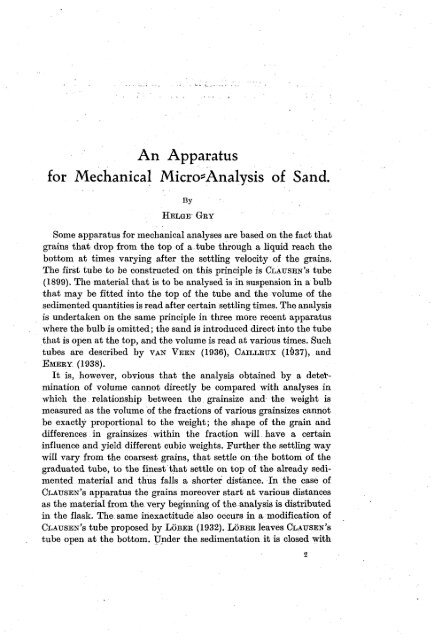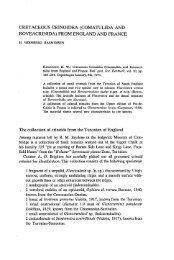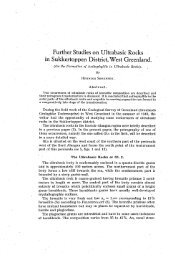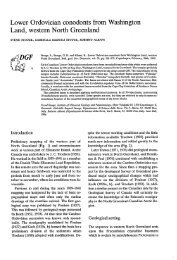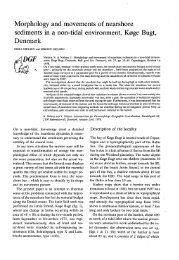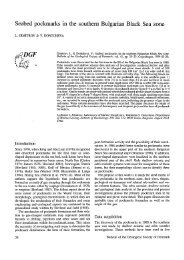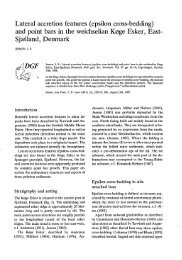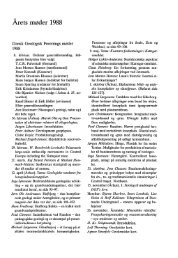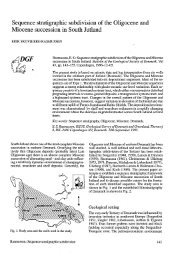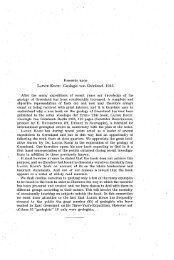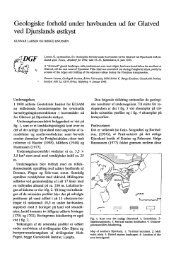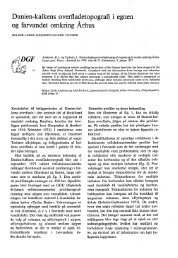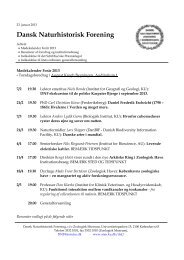Meddelelser fra Dansk Geologisk Forening 1941, bind 10, hæfte 1, s ...
Meddelelser fra Dansk Geologisk Forening 1941, bind 10, hæfte 1, s ...
Meddelelser fra Dansk Geologisk Forening 1941, bind 10, hæfte 1, s ...
Create successful ePaper yourself
Turn your PDF publications into a flip-book with our unique Google optimized e-Paper software.
An Apparatus<br />
for Mechanical Micro^^Analysis of Sand.<br />
By<br />
HELGE GEY<br />
Some apparatus for mechanical analyses are based on the fact that<br />
grains that drop from the top of a tube through a liquid reach the<br />
bottom at times varying after the settling velocity of the grains.<br />
The first tube to be constructed on this principle is CLAUSEN'S tube<br />
(1899). The material that is to be analysed is in suspension in a bulb<br />
that may be fitted into the top of the tube and the volume of the<br />
sedimented quantities is read after certain settling times. The analysis<br />
is undertaken on the same principle in three more recent apparatus<br />
where the bulb is omitted ; the sand is introduced direct into the tube<br />
that is open at the top, and the volume is read at various times. Such<br />
tubes are described by VAN VEEN (1936), CAILLETTX (1Ô37), and<br />
EMERY (1938).<br />
It is, however, obvious that the analysis obtained by a determination<br />
of volume cannot directly be compared with analyses in<br />
which the relationship between the grainsize and the weight is<br />
measured as the volume of the <strong>fra</strong>ctions of various grainsizes cannot<br />
be exactly proportional to the weight; the shape of the grain and<br />
differences in grainsizes within the <strong>fra</strong>ction will have a certain<br />
influence and yield different cubic weights. Further the settling way<br />
will vary from the coarsest grains, that settle on the bottom of the<br />
graduated tube, to the finest that settle on top of the already sedimented<br />
material and thus falls a shorter distance. In the case of<br />
CLAUSEN'S apparatus the grains moreover start at various distances<br />
as the material from the very beginning of the analysis is distributed<br />
in the flask. The same inexactitude also occurs in a modification of<br />
CLAUSEN'S tube proposed by LÖBER (1932). LÖBER leaves CLAUSEN'S<br />
tube open at the bottom. Under the sedimentation it is closed with
18 HEI-GE GRY: An Apparatus for Mechanical Micro-Analysis of Sand.<br />
a finger, and at various times it is opened under the water in small<br />
glass dishes into which the sediment falls so that the <strong>fra</strong>ctions may<br />
be weighed.<br />
Two apparatus yielding a .more exact separation after size and by<br />
means of which the sedimented quantities are weighed are described<br />
by KÜHL (1926 and 1927). A description of the latter apparatus—that<br />
are constructed for the purpose of analysing the grain distributions of<br />
cement—is found in a treatise by GBSSNER (1931). In the use of<br />
KÜHL'S earlier apparatus^that was fitted with nine décantation<br />
cocks at various heights—it appeared that the suspension at times<br />
behaved hke a liquid of a greater density and therefore dropped as a<br />
whole down through the settling tube. To avoid this in his new<br />
apparatus—where the sediment was collected from the bottom only—<br />
KÜHL used a heating device that gave the highest temperature at the<br />
top and caused sedimentation to take place undisturbed. Owing to the<br />
differences in temperature a close calculation of the settling velocities<br />
for the grainsizes is impossible, and the determination of the sizes<br />
must therefore in this case be made by microscopic measurements.<br />
In this article a simple apparatus is described that may be used for<br />
analysing small quantities of sand. Like other apparatus, working<br />
on similar principles, it is remarkable by the fact that the analyses<br />
are quickly made, and as is the case in KÜHL'S apparatus the measurements<br />
are inade by weighing. The drawback KÜHL mentions from<br />
his first apparatus that the suspension falls down as a whole through<br />
the apparatus does not occur when sufficiently small quantities of<br />
sand are used for the analyses. The apparatus has further the following<br />
advantages, in the first line it is excellently suited for analyses<br />
of quite small quantities of material and secondly the various <strong>fra</strong>ctions<br />
are separated which is of importance for a subsequent mineralogical<br />
analysis of the material.<br />
The apparatus consists of a 1 m long glass tube the interior diameter<br />
of which is 30 mm. At. the bottom the tube is conic the inside diameter<br />
being reduced over a distance of 12 cm to 5 mm. At the bottom<br />
end a rubber tube closed with a pinch cock is fitted while distilled<br />
water is poured in till sedimentation is to take place.<br />
At the top the tube may be closed with a rubber stopper in which<br />
is fitted a funnel with a glass cock as well as a container for the<br />
material that is to be analysed. This container (fig. IC) consists of a<br />
closed glass tube with an interior diameter of 7 mm and is abt. 20 mm<br />
long.. It turns downward when the stopper is fitted in.
Medd. <strong>fra</strong> <strong>Dansk</strong> Geol. <strong>Forening</strong>. København. Bd. <strong>10</strong> [<strong>1941</strong>]. 19<br />
The analysis takes place in the following way:<br />
The sand that is to be analysed is introduced into the sediment<br />
container—for instance by means of a device consisting of a funnel<br />
(fig. IE) which by means of a rubber<br />
ring is placed in the sediment container.<br />
The funnel, that at top is about <strong>10</strong> mm<br />
in inside diameter, and at bottom ends<br />
in an opening of scarcely 2 mm is haK<br />
filled with water, the material is intro- c<br />
duced and the grains settle down into<br />
the container. Grains, if any, that have<br />
settled on the walls of the funnel are<br />
brought down by stirring the liquid with<br />
a wire. When the sedimentation is finished<br />
the funnel is removed. It is closed at the<br />
top by means of a rubber stopper that<br />
is pierced and fitted with a rubber tube<br />
which after the fitting is again closed by<br />
means of a pinch cock. The funnel being<br />
thus closed can be removed without agitating<br />
the material in the container.<br />
When the sediment is to be introduced<br />
into the settling tube the container must<br />
be quite filled with water and the glass<br />
cock in the stopper must be left open.<br />
The stopper with the container is now<br />
rapidly turned upside down so that the<br />
edge of the container is immerged under<br />
the surface of the water in the filled tube<br />
whereafter sedimentation begins. Simul<br />
taneously a stop clock is started by an<br />
assistant who records the settling times.<br />
Fig. 1.<br />
The stopper at the upper end of the tube is quickly pressed down<br />
and the glass cock closed ; the rubber tube is then removed from the<br />
lower end of the settling tube. As the device is now quite closed at<br />
the top the water with the sedimenting material remains in the tube.<br />
The material is collected in carefully weighed watch glasses into<br />
which a little distilled water has been poured. If the liquid in the watch<br />
glass is held quite close to the bottom of the tube all the material<br />
that has reached the bottom will settle into the watch glass. At suit-
20 HELGE GRY: An Apparatus for Mechanical Micro-Analysis of Sand.<br />
able intervals a watch glass is removed with a quick movement, the<br />
settling time is recorded by the assistant, and a fresh watch glass is<br />
used for the collection of the next <strong>fra</strong>ction. The watch glasses with<br />
their contents are dried in a drying oven and weighed by means of<br />
analysing scales.<br />
If the sediment analysed,contains fine material this may be collected<br />
on filter paper the filter device being then placed under the<br />
tube and the glass cock at the top of the apparatus is slightly opened.<br />
The filtration may take place by means of the device that is described<br />
by the author in <strong>1941</strong> (GEY <strong>1941</strong>). "<br />
For determination of the grain size I have traced curves showing<br />
the relationship between the settling velocity in sec. for <strong>10</strong>0 cm settling<br />
and the diameter in mm. Such curves are traced on double<br />
logarithmic paper for temperatures of 5,<strong>10</strong>,15, and 18°, and by interpolation<br />
the grainsize is found at the various setthng times in the<br />
different experiments. The setthng times are calculated after RXJBEY'S<br />
formula, which according to the author's investigations (1940), yield<br />
more correct results than those of Oseen.<br />
The results of the analyses are most simply traced as cumulative<br />
curves as the grainsize intervals of the <strong>fra</strong>ctions are of unequal sizes.<br />
The analyses are also suited for the graphic computation of mean<br />
grainsize, mean deviation, etc. on probabihty net.<br />
Measurements under the microscope have shown that the <strong>fra</strong>ctions<br />
obtained in the apparatus described are well assorted, and the diameters<br />
of the grains he within the hmits determined by the settling<br />
velocities. Still, there are a few grains that are too fine and a few that<br />
are too coarse—as is also the case when other elutriation methods are<br />
apphed—but not so many that the result of the analysis is influenced.<br />
A change in the results appears, however, if more than abt. 300 mg<br />
are used for the analysis as the sediment then apparently becomes<br />
coarser because fine grains are carried down through the tube together<br />
with the coarsest.<br />
The apparatus has by the author been used for mechanical analyses<br />
of the sand that is brought into suspension owing to the tidal currents<br />
in the Danish shallows (GRY <strong>1941</strong>). The samples that are analysed<br />
have contained from a few mg up to <strong>10</strong>0 mg sand.<br />
The author is convinced that the apparatus will be of importance<br />
where a mechanical analysis of quite small sand quantities is desired,<br />
for instance for the study of fine stratification in sanded sediments,<br />
for analysis of small boring samples, of samples of suspended material<br />
from rivers, streams, etc.
Medd. <strong>fra</strong> <strong>Dansk</strong> Geol. <strong>Forening</strong>. København. Bd. <strong>10</strong> [<strong>1941</strong>]. 21<br />
REFERENCES'<br />
CAILLEUX, ANDRÉ: Analyseur hydraulique pour sables. •— C. R. S. de la Soc. géol.<br />
de France No 8. 1937.<br />
CLAUSEN 1899, see WAHNSCHAFFE-SCHUCHT.<br />
EMERY, K. O.: Rapid Method of Mechanical Analysis of Sands. — Journ. Sed. Petr.,<br />
Vol. 8. No 3. 1938.<br />
GESSNER, HERMANN: Die Schlämmanalyse. Leipzig 1931.<br />
GRY, HELGE: A Comparison between Sieving-, Elutriation- and Measure-Analyses<br />
of Sand. — Medd. <strong>Dansk</strong> Geol. Foren. Bd. 9. — København. 1940.<br />
GRY, HELGE : Quantitative Untersuchungen über den Sinkstofftransport durch Gezeitenströmungen.<br />
Folia Geographica Danica. Tom. II. Nr. 1. — København<br />
<strong>1941</strong>.<br />
KÜHL, see GESSNER.<br />
LöBER, H. : Ein besonders einfaches Verfahren der Schlämmanalyse. — Centralblatt<br />
f. Mineralogie, Abt. B. 1932.<br />
WAHNSCHAFFE-SCHUCHT: Wissenschaftliche Bodenuntersuchung. — Berlin 1924.<br />
VAN VEEN: Onderzoekingen in de Hoof den. — s'Gravenhage 1936.<br />
Resumé.<br />
Der gives en Beskrivelse af et Apparat, der kan anvendes til Kornstørrelsesanalyse<br />
af ganske smaa Sandmængder. Analysen grundes paa<br />
det Faktum, at forskelligt store Korn, der falder gennem en stillestaaende<br />
Vædskesøjle <strong>fra</strong> dennes Overflade, naar Bunden til forskellig Tid alt efter<br />
Kornenes Faldhastighed. Med passende Mellemrum kan det sedimenterede<br />
Materiale opsamles <strong>fra</strong> Bunden, tørres og vejes. Apparatet, der har været<br />
anvendt til Analyser af opslemmet Materiale <strong>fra</strong> Vadehavet, vil især kunne<br />
faa Betydning ved Undersøgelser, til hvilke der kun kan tilvejebringes<br />
et lille Materiale, f. Eks. ved Studiet af Finlagdeling i sandede Sedimenter,<br />
ved Analyse af smaa Boreprøver, af Prøver af opslemmet Materiale <strong>fra</strong><br />
Floder og andre Strømme o. s. v.<br />
Færdig <strong>fra</strong> Trykkeriet 6. Januar 1942.


